Financial Management Report: BSBFIM501, Business College, 2024
VerifiedAdded on 2022/08/16
|14
|3073
|11
Report
AI Summary
This report, prepared by a student, addresses the core principles of financial management, aligning with the BSBFIM501 curriculum. It delves into crucial aspects such as ensuring correct accounting entries, the significance of data analysis for informed decision-making, and the importance of accurate financial reporting. The report outlines the essential resources and systems required for effective financial management, including computer literacy and robust record-keeping. It further details the processes for monitoring and controlling expenditures, including budgeting and financial control. Key documents for financial management effectiveness are identified, alongside a comprehensive explanation of Goods and Services Tax (GST) registration and implications. The report also covers essential business records for employees, income tax, and PAYG withholding, including fuel tax credits, and the legal requirements for maintaining these records. The report concludes with a discussion on the importance of consulting relevant personnel when implementing budget and financial plan changes and outlines communication tools used for disseminating budget details to team members.
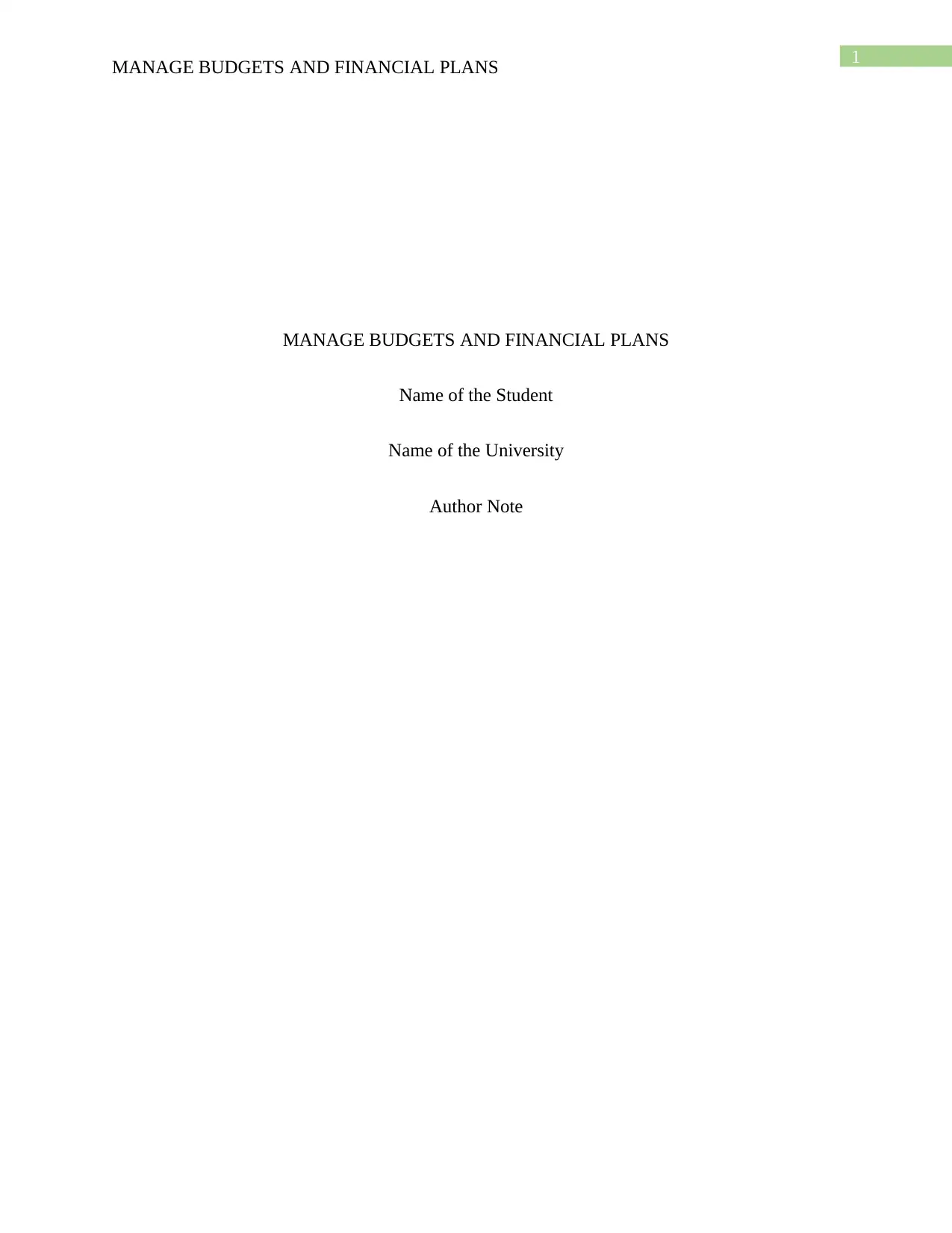
1
MANAGE BUDGETS AND FINANCIAL PLANS
MANAGE BUDGETS AND FINANCIAL PLANS
Name of the Student
Name of the University
Author Note
MANAGE BUDGETS AND FINANCIAL PLANS
MANAGE BUDGETS AND FINANCIAL PLANS
Name of the Student
Name of the University
Author Note
Paraphrase This Document
Need a fresh take? Get an instant paraphrase of this document with our AI Paraphraser
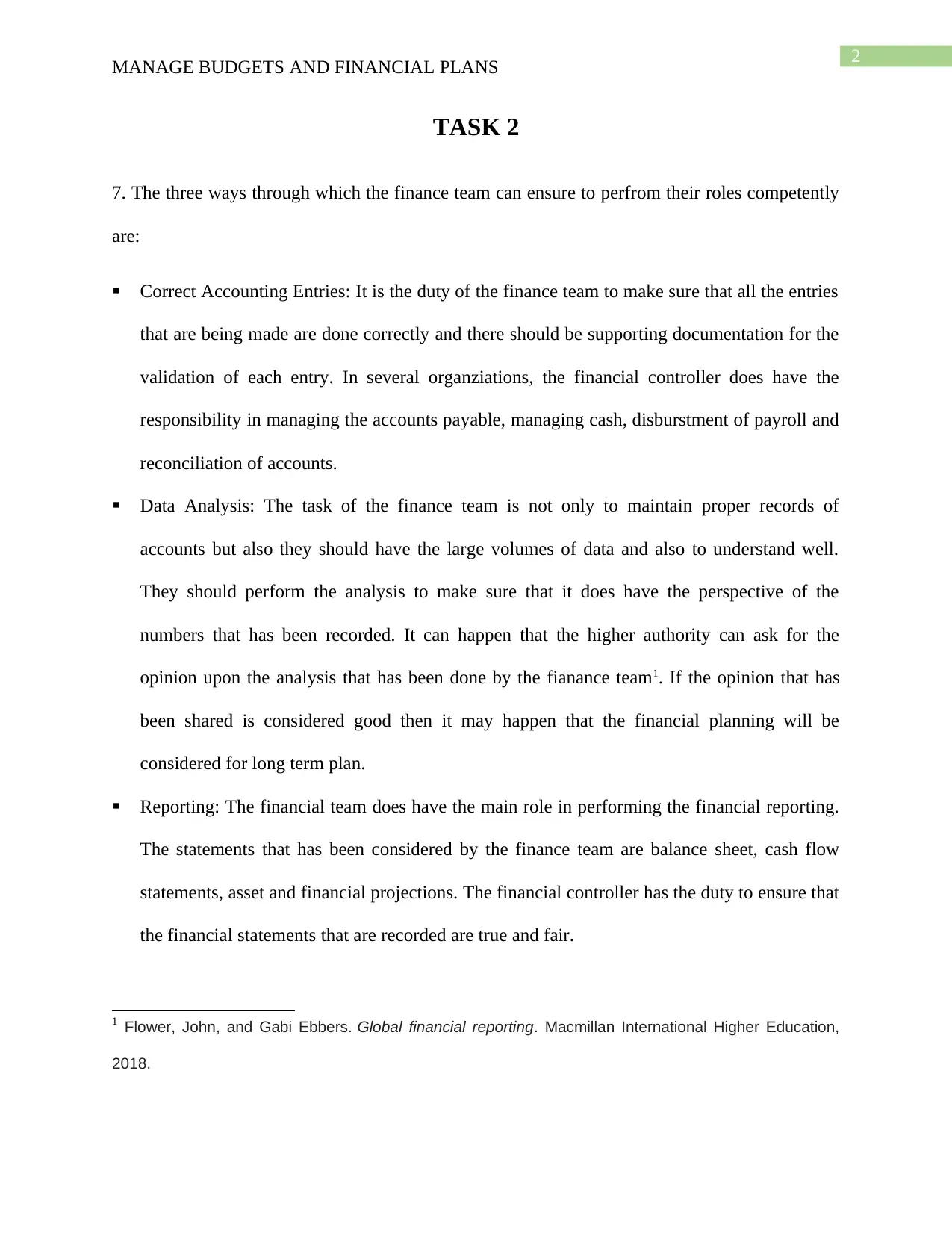
2
MANAGE BUDGETS AND FINANCIAL PLANS
TASK 2
7. The three ways through which the finance team can ensure to perfrom their roles competently
are:
Correct Accounting Entries: It is the duty of the finance team to make sure that all the entries
that are being made are done correctly and there should be supporting documentation for the
validation of each entry. In several organziations, the financial controller does have the
responsibility in managing the accounts payable, managing cash, disburstment of payroll and
reconciliation of accounts.
Data Analysis: The task of the finance team is not only to maintain proper records of
accounts but also they should have the large volumes of data and also to understand well.
They should perform the analysis to make sure that it does have the perspective of the
numbers that has been recorded. It can happen that the higher authority can ask for the
opinion upon the analysis that has been done by the fianance team1. If the opinion that has
been shared is considered good then it may happen that the financial planning will be
considered for long term plan.
Reporting: The financial team does have the main role in performing the financial reporting.
The statements that has been considered by the finance team are balance sheet, cash flow
statements, asset and financial projections. The financial controller has the duty to ensure that
the financial statements that are recorded are true and fair.
1 Flower, John, and Gabi Ebbers. Global financial reporting. Macmillan International Higher Education,
2018.
MANAGE BUDGETS AND FINANCIAL PLANS
TASK 2
7. The three ways through which the finance team can ensure to perfrom their roles competently
are:
Correct Accounting Entries: It is the duty of the finance team to make sure that all the entries
that are being made are done correctly and there should be supporting documentation for the
validation of each entry. In several organziations, the financial controller does have the
responsibility in managing the accounts payable, managing cash, disburstment of payroll and
reconciliation of accounts.
Data Analysis: The task of the finance team is not only to maintain proper records of
accounts but also they should have the large volumes of data and also to understand well.
They should perform the analysis to make sure that it does have the perspective of the
numbers that has been recorded. It can happen that the higher authority can ask for the
opinion upon the analysis that has been done by the fianance team1. If the opinion that has
been shared is considered good then it may happen that the financial planning will be
considered for long term plan.
Reporting: The financial team does have the main role in performing the financial reporting.
The statements that has been considered by the finance team are balance sheet, cash flow
statements, asset and financial projections. The financial controller has the duty to ensure that
the financial statements that are recorded are true and fair.
1 Flower, John, and Gabi Ebbers. Global financial reporting. Macmillan International Higher Education,
2018.
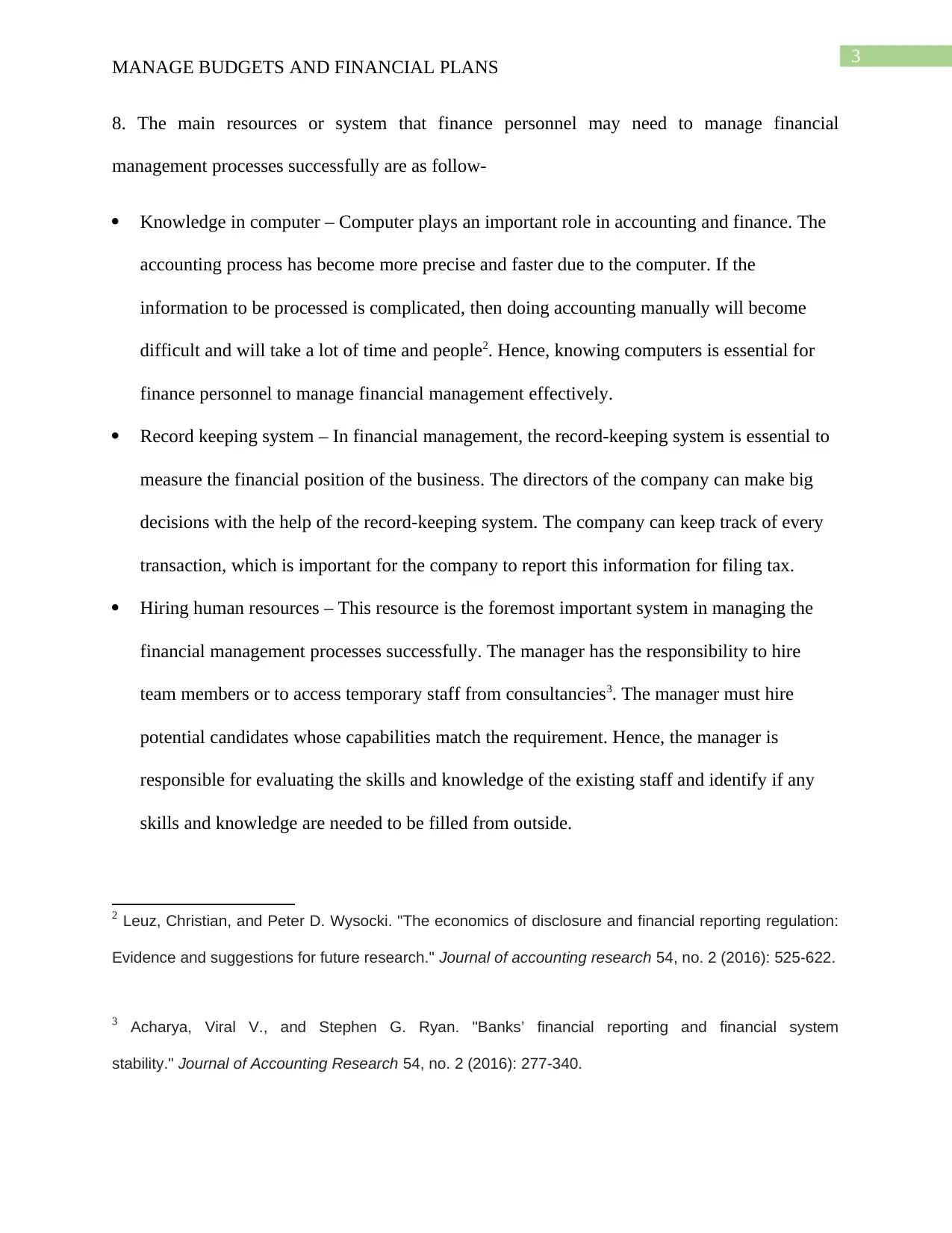
3
MANAGE BUDGETS AND FINANCIAL PLANS
8. The main resources or system that finance personnel may need to manage financial
management processes successfully are as follow-
Knowledge in computer – Computer plays an important role in accounting and finance. The
accounting process has become more precise and faster due to the computer. If the
information to be processed is complicated, then doing accounting manually will become
difficult and will take a lot of time and people2. Hence, knowing computers is essential for
finance personnel to manage financial management effectively.
Record keeping system – In financial management, the record-keeping system is essential to
measure the financial position of the business. The directors of the company can make big
decisions with the help of the record-keeping system. The company can keep track of every
transaction, which is important for the company to report this information for filing tax.
Hiring human resources – This resource is the foremost important system in managing the
financial management processes successfully. The manager has the responsibility to hire
team members or to access temporary staff from consultancies3. The manager must hire
potential candidates whose capabilities match the requirement. Hence, the manager is
responsible for evaluating the skills and knowledge of the existing staff and identify if any
skills and knowledge are needed to be filled from outside.
2 Leuz, Christian, and Peter D. Wysocki. "The economics of disclosure and financial reporting regulation:
Evidence and suggestions for future research." Journal of accounting research 54, no. 2 (2016): 525-622.
3 Acharya, Viral V., and Stephen G. Ryan. "Banks’ financial reporting and financial system
stability." Journal of Accounting Research 54, no. 2 (2016): 277-340.
MANAGE BUDGETS AND FINANCIAL PLANS
8. The main resources or system that finance personnel may need to manage financial
management processes successfully are as follow-
Knowledge in computer – Computer plays an important role in accounting and finance. The
accounting process has become more precise and faster due to the computer. If the
information to be processed is complicated, then doing accounting manually will become
difficult and will take a lot of time and people2. Hence, knowing computers is essential for
finance personnel to manage financial management effectively.
Record keeping system – In financial management, the record-keeping system is essential to
measure the financial position of the business. The directors of the company can make big
decisions with the help of the record-keeping system. The company can keep track of every
transaction, which is important for the company to report this information for filing tax.
Hiring human resources – This resource is the foremost important system in managing the
financial management processes successfully. The manager has the responsibility to hire
team members or to access temporary staff from consultancies3. The manager must hire
potential candidates whose capabilities match the requirement. Hence, the manager is
responsible for evaluating the skills and knowledge of the existing staff and identify if any
skills and knowledge are needed to be filled from outside.
2 Leuz, Christian, and Peter D. Wysocki. "The economics of disclosure and financial reporting regulation:
Evidence and suggestions for future research." Journal of accounting research 54, no. 2 (2016): 525-622.
3 Acharya, Viral V., and Stephen G. Ryan. "Banks’ financial reporting and financial system
stability." Journal of Accounting Research 54, no. 2 (2016): 277-340.
⊘ This is a preview!⊘
Do you want full access?
Subscribe today to unlock all pages.

Trusted by 1+ million students worldwide
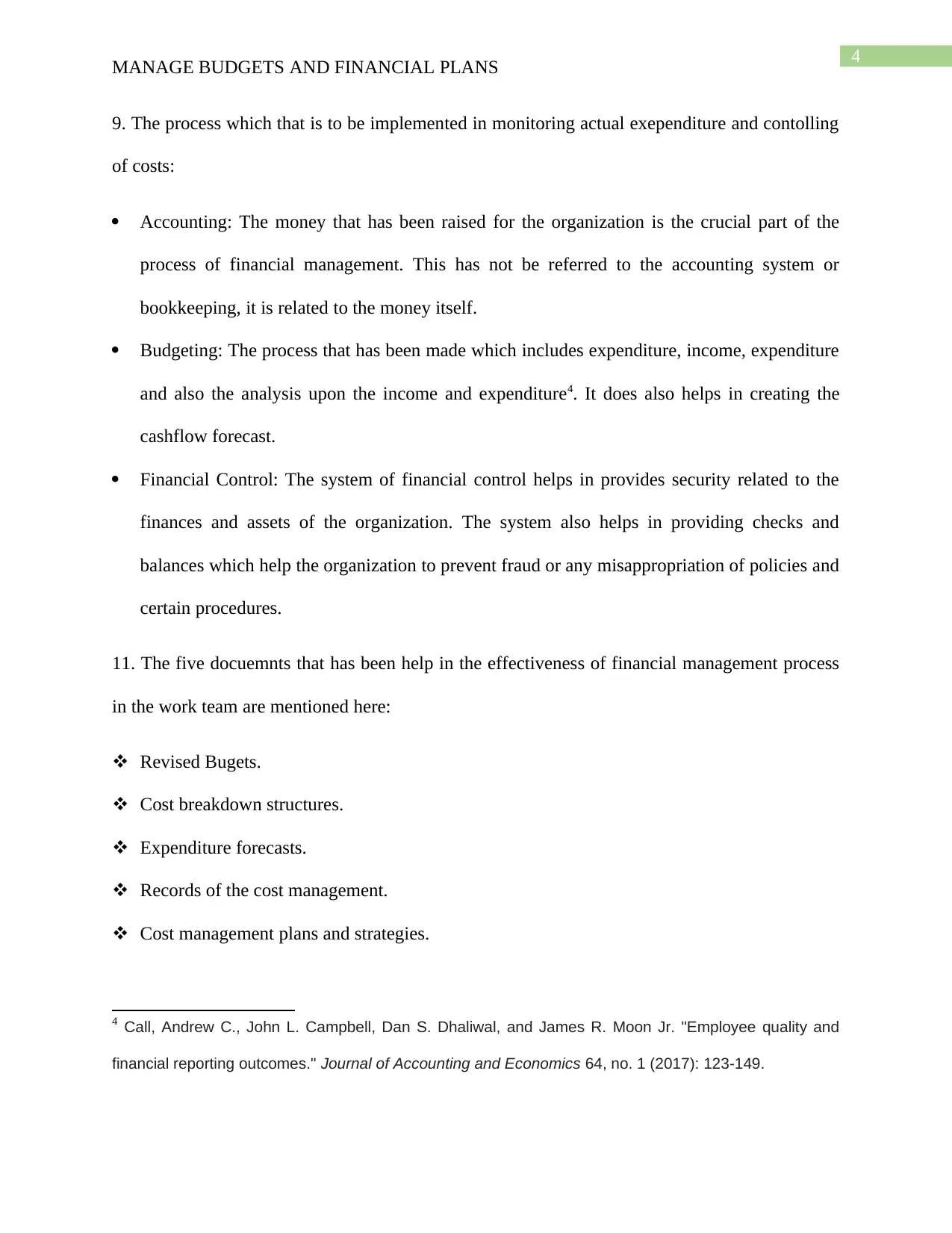
4
MANAGE BUDGETS AND FINANCIAL PLANS
9. The process which that is to be implemented in monitoring actual exependiture and contolling
of costs:
Accounting: The money that has been raised for the organization is the crucial part of the
process of financial management. This has not be referred to the accounting system or
bookkeeping, it is related to the money itself.
Budgeting: The process that has been made which includes expenditure, income, expenditure
and also the analysis upon the income and expenditure4. It does also helps in creating the
cashflow forecast.
Financial Control: The system of financial control helps in provides security related to the
finances and assets of the organization. The system also helps in providing checks and
balances which help the organization to prevent fraud or any misappropriation of policies and
certain procedures.
11. The five docuemnts that has been help in the effectiveness of financial management process
in the work team are mentioned here:
Revised Bugets.
Cost breakdown structures.
Expenditure forecasts.
Records of the cost management.
Cost management plans and strategies.
4 Call, Andrew C., John L. Campbell, Dan S. Dhaliwal, and James R. Moon Jr. "Employee quality and
financial reporting outcomes." Journal of Accounting and Economics 64, no. 1 (2017): 123-149.
MANAGE BUDGETS AND FINANCIAL PLANS
9. The process which that is to be implemented in monitoring actual exependiture and contolling
of costs:
Accounting: The money that has been raised for the organization is the crucial part of the
process of financial management. This has not be referred to the accounting system or
bookkeeping, it is related to the money itself.
Budgeting: The process that has been made which includes expenditure, income, expenditure
and also the analysis upon the income and expenditure4. It does also helps in creating the
cashflow forecast.
Financial Control: The system of financial control helps in provides security related to the
finances and assets of the organization. The system also helps in providing checks and
balances which help the organization to prevent fraud or any misappropriation of policies and
certain procedures.
11. The five docuemnts that has been help in the effectiveness of financial management process
in the work team are mentioned here:
Revised Bugets.
Cost breakdown structures.
Expenditure forecasts.
Records of the cost management.
Cost management plans and strategies.
4 Call, Andrew C., John L. Campbell, Dan S. Dhaliwal, and James R. Moon Jr. "Employee quality and
financial reporting outcomes." Journal of Accounting and Economics 64, no. 1 (2017): 123-149.
Paraphrase This Document
Need a fresh take? Get an instant paraphrase of this document with our AI Paraphraser

5
MANAGE BUDGETS AND FINANCIAL PLANS
12. Goods and services tax (GST) is a value-added tax charged on goods and services sold for
domestic use. The tax is included in the final price of the product and is paid by the consumer at
the time of purchasing the product. It is transferred to the government by the seller. GST is a
single tax rate charged across a nation.
The GST in Australia is charged at 10% on goods and services sold and consumed along with
some exemptions on certain food, healthcare and housing items5. There is a need to register for
GST if:
A business or an entity is having a turnover of $75000.
There is a need to claim fuel tax credits for any business or entity.
The entity is providing travelling expenses for passengers in exchange for a fare as part
of its enterprise, regardless of the GST turnover of the business.
Registering for GST is optional if the business does not fit into any one of these categories.
However, if the company choose to do so or is willing to register, it needs to stay registered for
at least 12 months.
13. The businesses which are to be registered for GST in Australia have been explained below:
A business or an entity having a turnover of $75000 is subjected to register for GST.
Any non-profit organisation having a GST turnover of $150,000 or more are entitled to
make registration.
5 Johnston, Rick, and Reining Petacchi. "Regulatory oversight of financial reporting: Securities and
Exchange Commission comment letters." Contemporary Accounting Research 34, no. 2 (2017): 1128-
1155.
MANAGE BUDGETS AND FINANCIAL PLANS
12. Goods and services tax (GST) is a value-added tax charged on goods and services sold for
domestic use. The tax is included in the final price of the product and is paid by the consumer at
the time of purchasing the product. It is transferred to the government by the seller. GST is a
single tax rate charged across a nation.
The GST in Australia is charged at 10% on goods and services sold and consumed along with
some exemptions on certain food, healthcare and housing items5. There is a need to register for
GST if:
A business or an entity is having a turnover of $75000.
There is a need to claim fuel tax credits for any business or entity.
The entity is providing travelling expenses for passengers in exchange for a fare as part
of its enterprise, regardless of the GST turnover of the business.
Registering for GST is optional if the business does not fit into any one of these categories.
However, if the company choose to do so or is willing to register, it needs to stay registered for
at least 12 months.
13. The businesses which are to be registered for GST in Australia have been explained below:
A business or an entity having a turnover of $75000 is subjected to register for GST.
Any non-profit organisation having a GST turnover of $150,000 or more are entitled to
make registration.
5 Johnston, Rick, and Reining Petacchi. "Regulatory oversight of financial reporting: Securities and
Exchange Commission comment letters." Contemporary Accounting Research 34, no. 2 (2017): 1128-
1155.
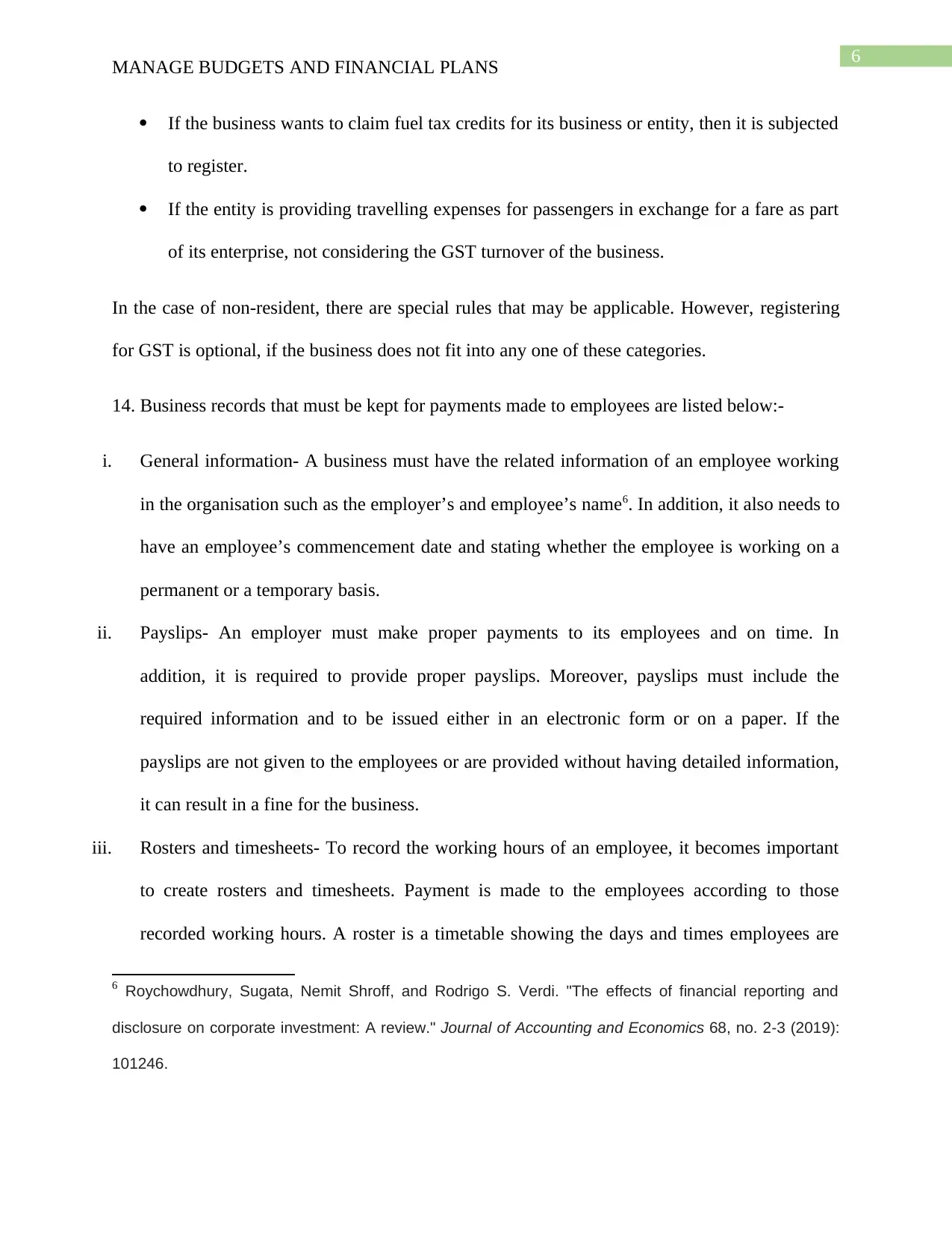
6
MANAGE BUDGETS AND FINANCIAL PLANS
If the business wants to claim fuel tax credits for its business or entity, then it is subjected
to register.
If the entity is providing travelling expenses for passengers in exchange for a fare as part
of its enterprise, not considering the GST turnover of the business.
In the case of non-resident, there are special rules that may be applicable. However, registering
for GST is optional, if the business does not fit into any one of these categories.
14. Business records that must be kept for payments made to employees are listed below:-
i. General information- A business must have the related information of an employee working
in the organisation such as the employer’s and employee’s name6. In addition, it also needs to
have an employee’s commencement date and stating whether the employee is working on a
permanent or a temporary basis.
ii. Payslips- An employer must make proper payments to its employees and on time. In
addition, it is required to provide proper payslips. Moreover, payslips must include the
required information and to be issued either in an electronic form or on a paper. If the
payslips are not given to the employees or are provided without having detailed information,
it can result in a fine for the business.
iii. Rosters and timesheets- To record the working hours of an employee, it becomes important
to create rosters and timesheets. Payment is made to the employees according to those
recorded working hours. A roster is a timetable showing the days and times employees are
6 Roychowdhury, Sugata, Nemit Shroff, and Rodrigo S. Verdi. "The effects of financial reporting and
disclosure on corporate investment: A review." Journal of Accounting and Economics 68, no. 2-3 (2019):
101246.
MANAGE BUDGETS AND FINANCIAL PLANS
If the business wants to claim fuel tax credits for its business or entity, then it is subjected
to register.
If the entity is providing travelling expenses for passengers in exchange for a fare as part
of its enterprise, not considering the GST turnover of the business.
In the case of non-resident, there are special rules that may be applicable. However, registering
for GST is optional, if the business does not fit into any one of these categories.
14. Business records that must be kept for payments made to employees are listed below:-
i. General information- A business must have the related information of an employee working
in the organisation such as the employer’s and employee’s name6. In addition, it also needs to
have an employee’s commencement date and stating whether the employee is working on a
permanent or a temporary basis.
ii. Payslips- An employer must make proper payments to its employees and on time. In
addition, it is required to provide proper payslips. Moreover, payslips must include the
required information and to be issued either in an electronic form or on a paper. If the
payslips are not given to the employees or are provided without having detailed information,
it can result in a fine for the business.
iii. Rosters and timesheets- To record the working hours of an employee, it becomes important
to create rosters and timesheets. Payment is made to the employees according to those
recorded working hours. A roster is a timetable showing the days and times employees are
6 Roychowdhury, Sugata, Nemit Shroff, and Rodrigo S. Verdi. "The effects of financial reporting and
disclosure on corporate investment: A review." Journal of Accounting and Economics 68, no. 2-3 (2019):
101246.
⊘ This is a preview!⊘
Do you want full access?
Subscribe today to unlock all pages.

Trusted by 1+ million students worldwide
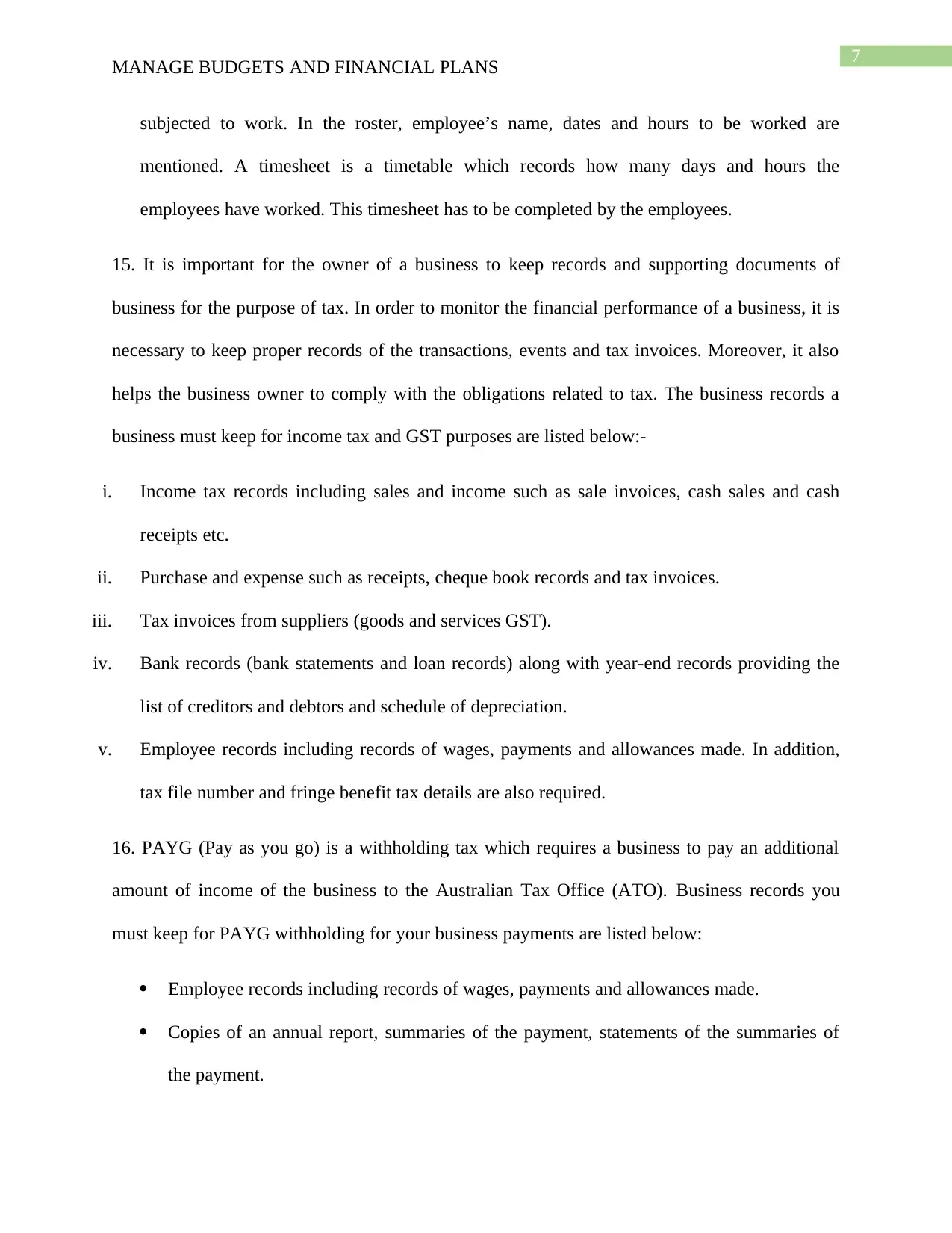
7
MANAGE BUDGETS AND FINANCIAL PLANS
subjected to work. In the roster, employee’s name, dates and hours to be worked are
mentioned. A timesheet is a timetable which records how many days and hours the
employees have worked. This timesheet has to be completed by the employees.
15. It is important for the owner of a business to keep records and supporting documents of
business for the purpose of tax. In order to monitor the financial performance of a business, it is
necessary to keep proper records of the transactions, events and tax invoices. Moreover, it also
helps the business owner to comply with the obligations related to tax. The business records a
business must keep for income tax and GST purposes are listed below:-
i. Income tax records including sales and income such as sale invoices, cash sales and cash
receipts etc.
ii. Purchase and expense such as receipts, cheque book records and tax invoices.
iii. Tax invoices from suppliers (goods and services GST).
iv. Bank records (bank statements and loan records) along with year-end records providing the
list of creditors and debtors and schedule of depreciation.
v. Employee records including records of wages, payments and allowances made. In addition,
tax file number and fringe benefit tax details are also required.
16. PAYG (Pay as you go) is a withholding tax which requires a business to pay an additional
amount of income of the business to the Australian Tax Office (ATO). Business records you
must keep for PAYG withholding for your business payments are listed below:
Employee records including records of wages, payments and allowances made.
Copies of an annual report, summaries of the payment, statements of the summaries of
the payment.
MANAGE BUDGETS AND FINANCIAL PLANS
subjected to work. In the roster, employee’s name, dates and hours to be worked are
mentioned. A timesheet is a timetable which records how many days and hours the
employees have worked. This timesheet has to be completed by the employees.
15. It is important for the owner of a business to keep records and supporting documents of
business for the purpose of tax. In order to monitor the financial performance of a business, it is
necessary to keep proper records of the transactions, events and tax invoices. Moreover, it also
helps the business owner to comply with the obligations related to tax. The business records a
business must keep for income tax and GST purposes are listed below:-
i. Income tax records including sales and income such as sale invoices, cash sales and cash
receipts etc.
ii. Purchase and expense such as receipts, cheque book records and tax invoices.
iii. Tax invoices from suppliers (goods and services GST).
iv. Bank records (bank statements and loan records) along with year-end records providing the
list of creditors and debtors and schedule of depreciation.
v. Employee records including records of wages, payments and allowances made. In addition,
tax file number and fringe benefit tax details are also required.
16. PAYG (Pay as you go) is a withholding tax which requires a business to pay an additional
amount of income of the business to the Australian Tax Office (ATO). Business records you
must keep for PAYG withholding for your business payments are listed below:
Employee records including records of wages, payments and allowances made.
Copies of an annual report, summaries of the payment, statements of the summaries of
the payment.
Paraphrase This Document
Need a fresh take? Get an instant paraphrase of this document with our AI Paraphraser

8
MANAGE BUDGETS AND FINANCIAL PLANS
Declaration of the tax file number and withholding declarations.
Records of the payment related to the termination of the employment.
Records of Personal Services Income (PSI) which employer have attributed.
Annual reports of PAYG withholding, statements by a supplier and records of amounts
the employer hold back where no ABN was mentioned.
17. To claim all the fuel tax credits one is entitled to; one must keep proper and adequate records.
Moreover, one may have to give back part all or part of the fuel tax credits that have been
received if claims are not supported with adequate records. Business records you must keep for
PAYG withholding for fuel tax credits are listed below:
i. Sales invoices, contracts, records of the production and driver log books along with lease
documents are required to be produced in case of carrying on a business.
ii. The date, type and quantity of fuel been manufactured, acquired and imported for the
business activities are to support with tax invoices, bank statements, receipts, fuel card
and supplier statements, manufacturing records.
iii. If the vehicle meets criteria related to the environment (the vehicle is a diesel vehicle
manufactured before 1 January 1996) then records of services, invoices, receipts and
maintenance schedules can be used in support.
iv. Records or screenshots from the Australian Tax Office fuel tax credit calculator,
calculation file can be used as support while computing the claim that the correct rate for
the fuel tax credit has been used.
v. For ensuring that the fuel has been used for operating business activities, one can provide
the records of hire, ownership of the vehicle along with the date of hire, maintenance
MANAGE BUDGETS AND FINANCIAL PLANS
Declaration of the tax file number and withholding declarations.
Records of the payment related to the termination of the employment.
Records of Personal Services Income (PSI) which employer have attributed.
Annual reports of PAYG withholding, statements by a supplier and records of amounts
the employer hold back where no ABN was mentioned.
17. To claim all the fuel tax credits one is entitled to; one must keep proper and adequate records.
Moreover, one may have to give back part all or part of the fuel tax credits that have been
received if claims are not supported with adequate records. Business records you must keep for
PAYG withholding for fuel tax credits are listed below:
i. Sales invoices, contracts, records of the production and driver log books along with lease
documents are required to be produced in case of carrying on a business.
ii. The date, type and quantity of fuel been manufactured, acquired and imported for the
business activities are to support with tax invoices, bank statements, receipts, fuel card
and supplier statements, manufacturing records.
iii. If the vehicle meets criteria related to the environment (the vehicle is a diesel vehicle
manufactured before 1 January 1996) then records of services, invoices, receipts and
maintenance schedules can be used in support.
iv. Records or screenshots from the Australian Tax Office fuel tax credit calculator,
calculation file can be used as support while computing the claim that the correct rate for
the fuel tax credit has been used.
v. For ensuring that the fuel has been used for operating business activities, one can provide
the records of hire, ownership of the vehicle along with the date of hire, maintenance
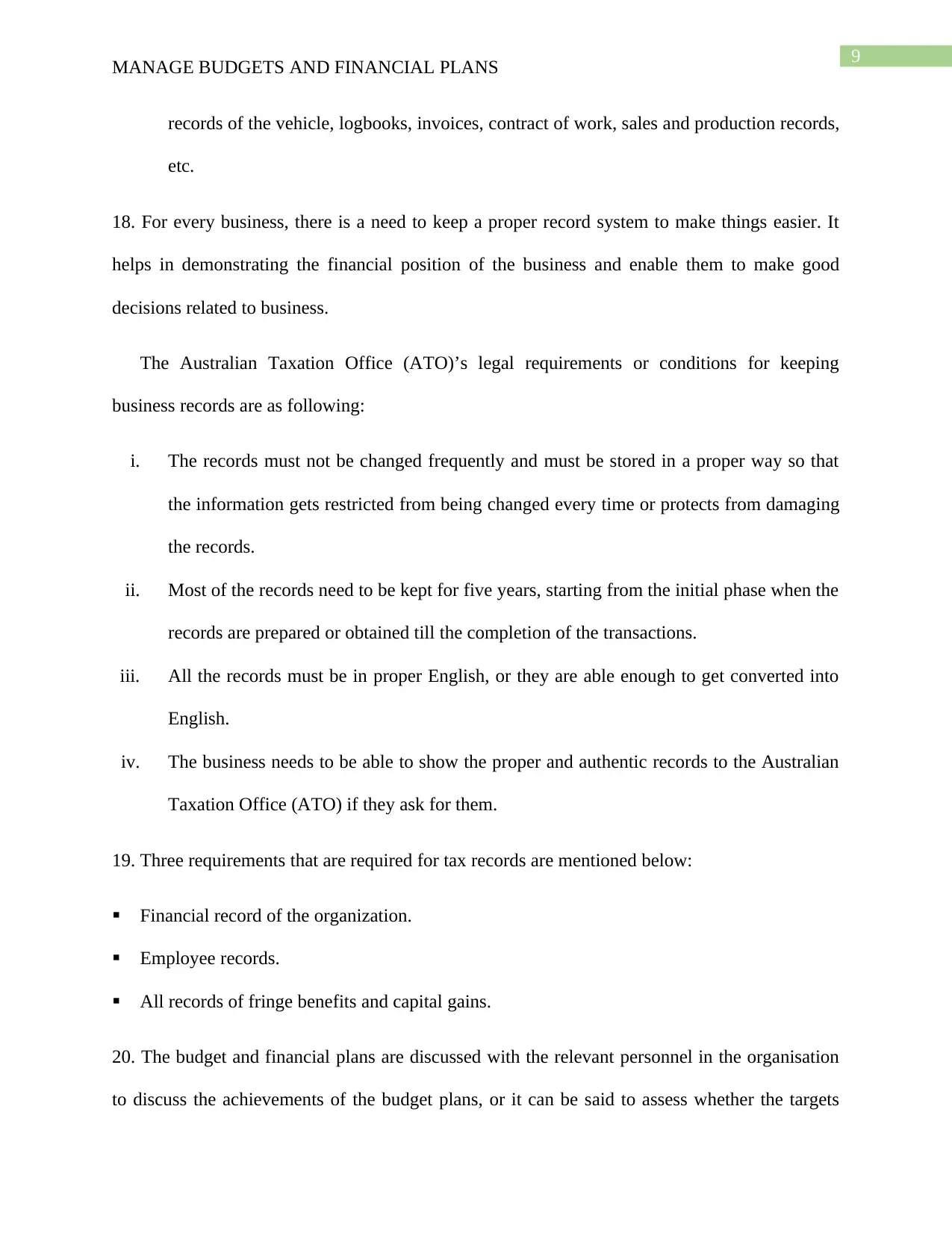
9
MANAGE BUDGETS AND FINANCIAL PLANS
records of the vehicle, logbooks, invoices, contract of work, sales and production records,
etc.
18. For every business, there is a need to keep a proper record system to make things easier. It
helps in demonstrating the financial position of the business and enable them to make good
decisions related to business.
The Australian Taxation Office (ATO)’s legal requirements or conditions for keeping
business records are as following:
i. The records must not be changed frequently and must be stored in a proper way so that
the information gets restricted from being changed every time or protects from damaging
the records.
ii. Most of the records need to be kept for five years, starting from the initial phase when the
records are prepared or obtained till the completion of the transactions.
iii. All the records must be in proper English, or they are able enough to get converted into
English.
iv. The business needs to be able to show the proper and authentic records to the Australian
Taxation Office (ATO) if they ask for them.
19. Three requirements that are required for tax records are mentioned below:
Financial record of the organization.
Employee records.
All records of fringe benefits and capital gains.
20. The budget and financial plans are discussed with the relevant personnel in the organisation
to discuss the achievements of the budget plans, or it can be said to assess whether the targets
MANAGE BUDGETS AND FINANCIAL PLANS
records of the vehicle, logbooks, invoices, contract of work, sales and production records,
etc.
18. For every business, there is a need to keep a proper record system to make things easier. It
helps in demonstrating the financial position of the business and enable them to make good
decisions related to business.
The Australian Taxation Office (ATO)’s legal requirements or conditions for keeping
business records are as following:
i. The records must not be changed frequently and must be stored in a proper way so that
the information gets restricted from being changed every time or protects from damaging
the records.
ii. Most of the records need to be kept for five years, starting from the initial phase when the
records are prepared or obtained till the completion of the transactions.
iii. All the records must be in proper English, or they are able enough to get converted into
English.
iv. The business needs to be able to show the proper and authentic records to the Australian
Taxation Office (ATO) if they ask for them.
19. Three requirements that are required for tax records are mentioned below:
Financial record of the organization.
Employee records.
All records of fringe benefits and capital gains.
20. The budget and financial plans are discussed with the relevant personnel in the organisation
to discuss the achievements of the budget plans, or it can be said to assess whether the targets
⊘ This is a preview!⊘
Do you want full access?
Subscribe today to unlock all pages.

Trusted by 1+ million students worldwide
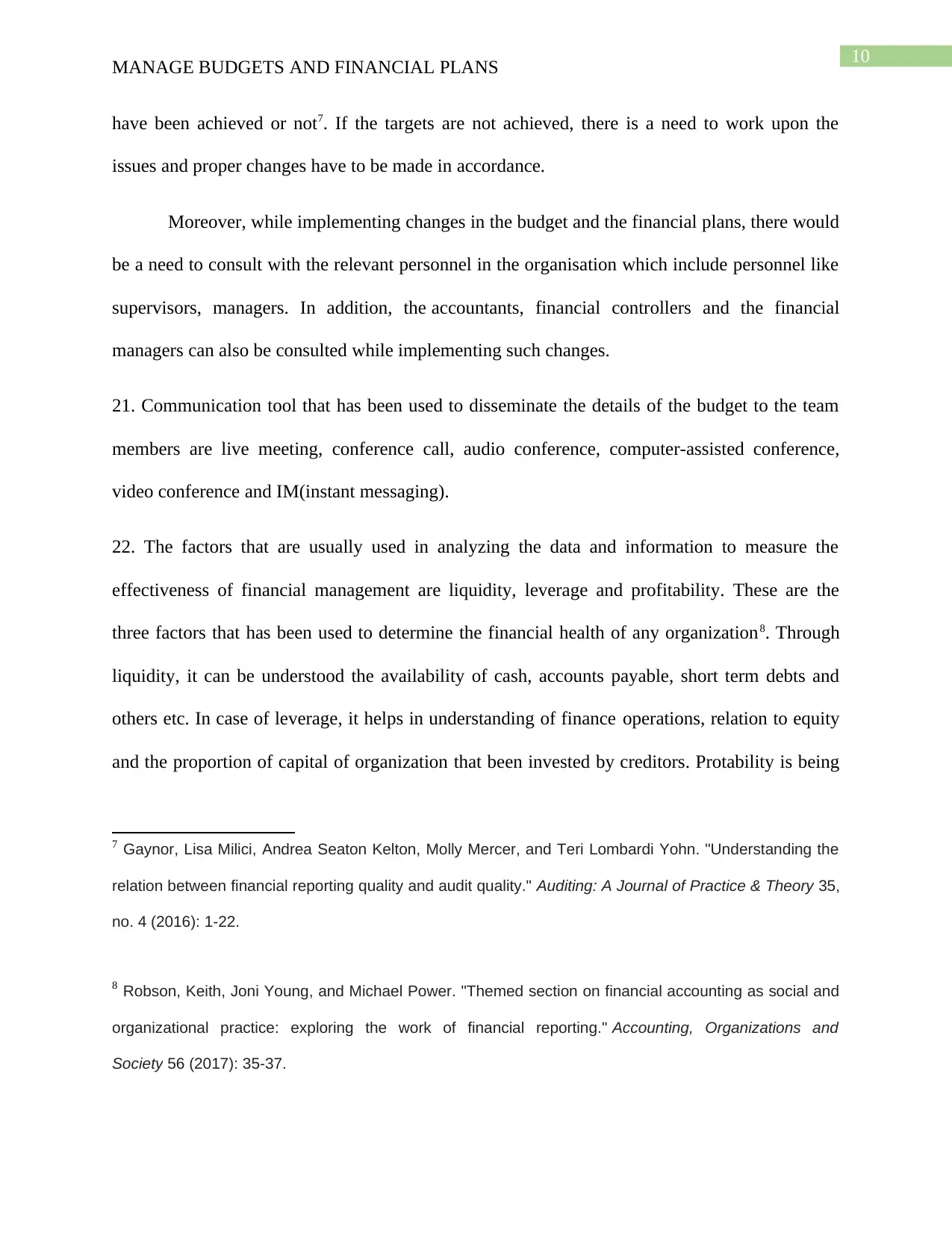
10
MANAGE BUDGETS AND FINANCIAL PLANS
have been achieved or not7. If the targets are not achieved, there is a need to work upon the
issues and proper changes have to be made in accordance.
Moreover, while implementing changes in the budget and the financial plans, there would
be a need to consult with the relevant personnel in the organisation which include personnel like
supervisors, managers. In addition, the accountants, financial controllers and the financial
managers can also be consulted while implementing such changes.
21. Communication tool that has been used to disseminate the details of the budget to the team
members are live meeting, conference call, audio conference, computer-assisted conference,
video conference and IM(instant messaging).
22. The factors that are usually used in analyzing the data and information to measure the
effectiveness of financial management are liquidity, leverage and profitability. These are the
three factors that has been used to determine the financial health of any organization8. Through
liquidity, it can be understood the availability of cash, accounts payable, short term debts and
others etc. In case of leverage, it helps in understanding of finance operations, relation to equity
and the proportion of capital of organization that been invested by creditors. Protability is being
7 Gaynor, Lisa Milici, Andrea Seaton Kelton, Molly Mercer, and Teri Lombardi Yohn. "Understanding the
relation between financial reporting quality and audit quality." Auditing: A Journal of Practice & Theory 35,
no. 4 (2016): 1-22.
8 Robson, Keith, Joni Young, and Michael Power. "Themed section on financial accounting as social and
organizational practice: exploring the work of financial reporting." Accounting, Organizations and
Society 56 (2017): 35-37.
MANAGE BUDGETS AND FINANCIAL PLANS
have been achieved or not7. If the targets are not achieved, there is a need to work upon the
issues and proper changes have to be made in accordance.
Moreover, while implementing changes in the budget and the financial plans, there would
be a need to consult with the relevant personnel in the organisation which include personnel like
supervisors, managers. In addition, the accountants, financial controllers and the financial
managers can also be consulted while implementing such changes.
21. Communication tool that has been used to disseminate the details of the budget to the team
members are live meeting, conference call, audio conference, computer-assisted conference,
video conference and IM(instant messaging).
22. The factors that are usually used in analyzing the data and information to measure the
effectiveness of financial management are liquidity, leverage and profitability. These are the
three factors that has been used to determine the financial health of any organization8. Through
liquidity, it can be understood the availability of cash, accounts payable, short term debts and
others etc. In case of leverage, it helps in understanding of finance operations, relation to equity
and the proportion of capital of organization that been invested by creditors. Protability is being
7 Gaynor, Lisa Milici, Andrea Seaton Kelton, Molly Mercer, and Teri Lombardi Yohn. "Understanding the
relation between financial reporting quality and audit quality." Auditing: A Journal of Practice & Theory 35,
no. 4 (2016): 1-22.
8 Robson, Keith, Joni Young, and Michael Power. "Themed section on financial accounting as social and
organizational practice: exploring the work of financial reporting." Accounting, Organizations and
Society 56 (2017): 35-37.
Paraphrase This Document
Need a fresh take? Get an instant paraphrase of this document with our AI Paraphraser

11
MANAGE BUDGETS AND FINANCIAL PLANS
used for checking the performance of management and also the financial return through which
the organization has been invested upon.
23. Improvements with financial objectives are implemented and monitored-
Preparation of financial statements- It is required to prepare the financial statement of the
company as it helps in improving the financial objective of the business and present a true
and fair view position of the organisation. Every company needs to prepare the balance sheet
and the profit & loss statement.
Preparation of Inventory records- The business needs to maintain a proper record of their
inventory such as plant & machinery, equipment and raw materials which will ultimately
help them in understanding how much stock was purchased and how much has been used in
making the final products9. This will enable them to know whether they need to purchase
more materials and if any equipment has gone missing.
Preparation of Working Capital statements and Financial ratios- The finance teams can be
asked by the manager to prepare the working capital statements and to make calculations of
current ratios and quick ratios10. The calculation and the preparation of statements help them
to know how many assets they have as compared to their liabilities. In addition, they can also
ensure how many assets of the company are liquid and can be converted quickly to cash.
9 Abbott, Lawrence J., Brian Daugherty, Susan Parker, and Gary F. Peters. "Internal audit quality and
financial reporting quality: The joint importance of independence and competence." Journal of Accounting
Research 54, no. 1 (2016): 3-40.
10 Bimo, Irenius Dwinanto, Sylvia Veronica Siregar, Ancella Anitawati Hermawan, and Ratna Wardhani.
"Internal Control Over Financial Reporting, Organizational Complexity, and Financial Reporting
Quality." International Journal of Economics and Management 13, no. 2 (2019): 331-342.
MANAGE BUDGETS AND FINANCIAL PLANS
used for checking the performance of management and also the financial return through which
the organization has been invested upon.
23. Improvements with financial objectives are implemented and monitored-
Preparation of financial statements- It is required to prepare the financial statement of the
company as it helps in improving the financial objective of the business and present a true
and fair view position of the organisation. Every company needs to prepare the balance sheet
and the profit & loss statement.
Preparation of Inventory records- The business needs to maintain a proper record of their
inventory such as plant & machinery, equipment and raw materials which will ultimately
help them in understanding how much stock was purchased and how much has been used in
making the final products9. This will enable them to know whether they need to purchase
more materials and if any equipment has gone missing.
Preparation of Working Capital statements and Financial ratios- The finance teams can be
asked by the manager to prepare the working capital statements and to make calculations of
current ratios and quick ratios10. The calculation and the preparation of statements help them
to know how many assets they have as compared to their liabilities. In addition, they can also
ensure how many assets of the company are liquid and can be converted quickly to cash.
9 Abbott, Lawrence J., Brian Daugherty, Susan Parker, and Gary F. Peters. "Internal audit quality and
financial reporting quality: The joint importance of independence and competence." Journal of Accounting
Research 54, no. 1 (2016): 3-40.
10 Bimo, Irenius Dwinanto, Sylvia Veronica Siregar, Ancella Anitawati Hermawan, and Ratna Wardhani.
"Internal Control Over Financial Reporting, Organizational Complexity, and Financial Reporting
Quality." International Journal of Economics and Management 13, no. 2 (2019): 331-342.

12
MANAGE BUDGETS AND FINANCIAL PLANS
Analysis of Overhead expenses- Preparing financial statement is not enough for a business.
There is a need to have a look at the weak areas also. In order to check those areas, it is
required to check the overhead expenses such as rent, rates, salaries, wages and other
marketing expenses. The proper checks are important as it ensures whether they are under
control or are impacting the profitability of the business.
MANAGE BUDGETS AND FINANCIAL PLANS
Analysis of Overhead expenses- Preparing financial statement is not enough for a business.
There is a need to have a look at the weak areas also. In order to check those areas, it is
required to check the overhead expenses such as rent, rates, salaries, wages and other
marketing expenses. The proper checks are important as it ensures whether they are under
control or are impacting the profitability of the business.
⊘ This is a preview!⊘
Do you want full access?
Subscribe today to unlock all pages.

Trusted by 1+ million students worldwide
1 out of 14
Related Documents
Your All-in-One AI-Powered Toolkit for Academic Success.
+13062052269
info@desklib.com
Available 24*7 on WhatsApp / Email
![[object Object]](/_next/static/media/star-bottom.7253800d.svg)
Unlock your academic potential
Copyright © 2020–2025 A2Z Services. All Rights Reserved. Developed and managed by ZUCOL.





